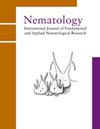Diversity of plant-parasitic nematodes associated with chickpea (Cicer arietinum L.) in the main growing areas of Ethiopia
IF 1.2
4区 生物学
Q2 ZOOLOGY
引用次数: 0
Abstract
Chickpea is one of the most important legume crops in Ethiopia; however, its production is far below the mean international chickpea production due to biotic and abiotic stressors. Plant-parasitic nematode infestation is extensive in chickpea-growing areas worldwide. The distribution and population density of plant-parasitic nematodes in chickpea were determined during the September-December 2021 growing season. Ten plant-parasitic nematode taxa were identified from 27 localities across ten districts in the main chickpea-growing areas in Ethiopia. Pratylenchus had the highest prominence values, followed by Rotylenchulus and Meloidogyne spp. Helicotylenchus, Hoplolaimus, Scutellonema and Quinisulcius were more prevalent than Criconemoides and Ditylenchus. Sequences of different molecular markers, including D2-D3 of 28S rDNA, ITS of rDNA, and COI and Nad5 of mtDNA, revealed the presence of Meloidogyne javanica, Rotylenchulus parvus, Scutellonema clathricaudatum and Helicotylenchus caudatus. Helicotylenchus caudatus and R. parvus are the first reports from Ethiopia and chickpea, while S. clathricaudatum is the first report for chickpea. This study provides essential baseline information of nematode pest occurrence on chickpea in Ethiopia. This information will raise awareness among growers, agricultural officers, and extension advisors, enabling them to develop effective nematode management strategies for the chickpea production system in Ethiopia.埃塞俄比亚主要种植区与鹰嘴豆(Cicer arietinum L.)有关的植物寄生线虫的多样性
鹰嘴豆是埃塞俄比亚最重要的豆类作物之一;然而,由于生物和非生物胁迫,其产量远远低于国际鹰嘴豆平均产量。植物寄生线虫侵扰在全世界鹰嘴豆种植区都很普遍。在 2021 年 9 月至 12 月的生长季节,对鹰嘴豆中植物寄生线虫的分布和种群密度进行了测定。在埃塞俄比亚主要鹰嘴豆种植区的 10 个县的 27 个地方,确定了 10 个植物寄生线虫类群。与 Criconemoides 和 Ditylenchus 相比,Helicotylenchus、Hoplolaimus、Scutellonema 和 Quinisulcius 更为普遍。不同分子标记(包括 28S rDNA 的 D2-D3、rDNA 的 ITS 以及 mtDNA 的 COI 和 Nad5)的序列显示存在爪哇旋毛虫(Meloidogyne javanica)、副旋毛虫(Rotylenchulus parvus)、Clathricaudatum 旋毛虫(Scutellonema clathricaudatum)和尾根卷叶螟(Helicotylenchus caudatus)。Helicotylenchus caudatus 和 R. parvus 是埃塞俄比亚和鹰嘴豆的首次报告,而 S. clathricaudatum 则是鹰嘴豆的首次报告。这项研究提供了埃塞俄比亚鹰嘴豆线虫发生情况的基本基准信息。这些信息将提高种植者、农业官员和推广顾问的认识,使他们能够为埃塞俄比亚鹰嘴豆生产系统制定有效的线虫管理策略。
本文章由计算机程序翻译,如有差异,请以英文原文为准。
求助全文
约1分钟内获得全文
求助全文
来源期刊

Nematology
生物-动物学
CiteScore
2.60
自引率
33.30%
发文量
67
审稿时长
3 months
期刊介绍:
Nematology is an international journal for the publication of all aspects of nematological research (with the exception of vertebrate parasitology), from molecular biology to field studies. Papers on nematode parasites of arthropods, and on soil free-living nematodes, and on interactions of these and other organisms, are particularly welcome. Research on fresh water and marine nematodes is also considered when the observations are of more general interest.
Nematology publishes full research papers, short communications, Forum articles (which permit an author to express a view on current or fundamental subjects), perspectives on nematology, and reviews of books and other media.
 求助内容:
求助内容: 应助结果提醒方式:
应助结果提醒方式:


